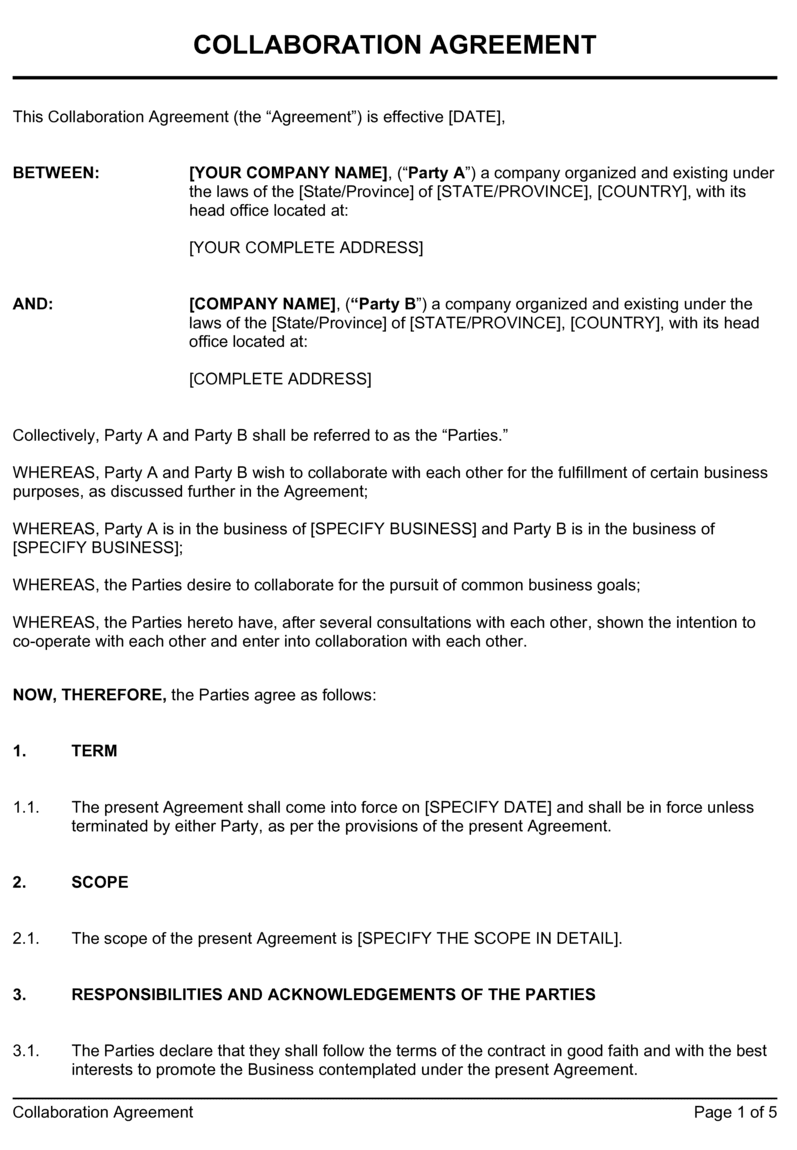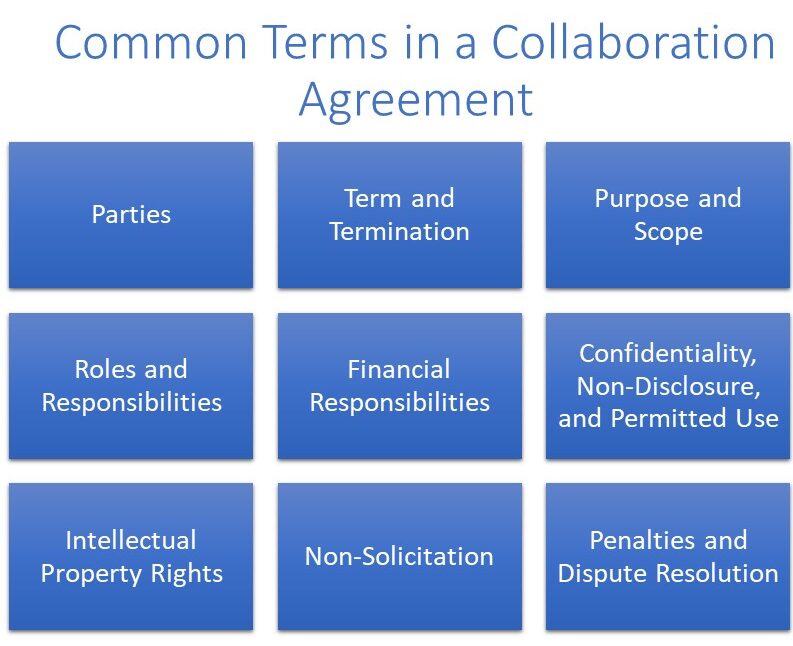How to Draft the Perfect Purchase Agreement
Nov 8th, 2023
Do you know how to write an effective collaboration agreement? Do you even know what a collaboration agreement is or why you need one? If you or your company is considering a partnership, you need a collaboration agreement to detail each party’s responsibilities. When it comes time to put all that in writing, turn to this ultimate guide to collaboration agreements, brought to you by the contract experts at Contract Logix.
Key Takeaways
- A collaboration agreement is a contract between parties collaborating on a single project.
- You need a collaboration agreement to protect your rights, define roles and responsibilities, and minimize legal risk.
- A collaboration agreement should define the parties involved, the terms of the project, purpose and scope, roles and responsibilities, and financial responsibilities.
- The agreement should include terms defining confidentiality and permitted use, intellectual property rights, non-solicitation of employees, and penalties and dispute resolution
😉 PS: Discover the secrets of efficient contract management HERE.
What is a Collaboration Agreement?
A collaboration agreement is a legally binding contract between two or more parties, aimed at a mutually beneficial project. Sometimes known as a joint venture agreement or strategic alliance agreement, a collaboration agreement is necessary to define each party’s roles and responsibilities.
Unlike a formal business partnership, a collaboration agreement zeroes in on a specific project, not an ongoing relationship, making it ideal for one-time collaborations.
A collaboration agreement should detail:
- What the collaborative project is about
- How the parties seek to work with one another
- How the benefits of the collaboration will be shared between the parties
- The responsibilities and obligations of each party
- Dispute resolution procedures
- How the contract can be terminated by either party.
Collaboration agreements can be short and simple or long and complex, depending on the needs of each party and the complexity of the project. In all cases, a collaboration agreement should align with your specific business needs and what your company wants to get from the collaboration.

SOURCE: https://www.business-in-a-box.com/template/collaboration-agreement-D13222/
Why Might You Need a Collaboration Agreement?
Any time your organization or business collaborates with another, you need a collaboration agreement. Be it a short-term project or a deeper joint venture, you need to document that relationship contractually.
A collaboration agreement not only determines roles but also ownership rights. For example, should the venture result in new intellectual property, it specifies which party owns it or how ownership is shared. By defining the venture in a collaboration agreement, there should be no confusion or conflict over how costs, profits, and assets are distributed.
While a collaboration agreement may not be legally necessary it is recommended. Without a collaboration agreement, you have to rely on verbal assurances, which might falter if disputes arise. A written collaboration agreement protects both parties from misunderstandings that might result in a legal dispute, reducing risk for both parties.
SOURCE: Legal Goodness via YouTube
What Terms Should Be Included in a Collaboration Agreement?
While every collaborative project is unique, every collaboration agreement should include the same fundamental components. These terms govern the collaboration, answering the following questions:
- Which parties are involved?
- What does the project entail?
- Which party is responsible for which tasks?
- Which party is owns which part of the collaboration (or profits or newly created assets)
- How will the collaboration operate?
- How does a party exit the collaboration?
We’ll examine the terms necessary to answer these and other questions in more detail.
Parties
At the outset, the collaboration agreement should detail all the parties involved in the agreement. This should include official entity names, addresses, and contact information—and, if necessary, the names of the key individuals responsible for managing the collaboration.
Term and Termination
The agreement should set out the term of the collaboration. This term can be for a fixed period or defined as an ongoing collaboration until certain goals are met or until termination by one or both parties. The collaboration agreement should also detail ways either party can terminate the agreement before the agreed upon end date, as well as any early termination penalties or fees that may accrue.
Purpose and Scope
What is the purpose of the collaboration—and what does it entail? The collaboration agreement should include a clear statement describing the purpose of the collaboration. It should include the project’s goals and objectives, as defined from the perspective of all parties—what each party hopes to achieve during the duration of the project. It should also include specific initiatives, projects, and activities that the parties agree to collaborate on.
The agreement should also elaborate on the scope of the project, distinguishing what’s involved and what’s not involved. This statement helps to define the parameters of the project and protect against scope creep.
Roles and Responsibilities
The collaboration agreement needs to define what is expected of each party. Each party’s role should be defined, as should each party’s responsibilities. Go into as much detail as possible to define the duties and obligations expected of each party.
Financial Responsibilities
Manpower is just one asset shared in a collaboration agreement. Each party is also responsible for contributing other resources, including funding. The collaboration agreement should detail each party’s financial responsibilities, including initial funding, ongoing expenses, and the like.
Confidentiality, Non-Disclosure, and Permitted Use
When working on a collaborative project, it’s important that key details be kept confidential. For that reason, the collaboration agreement should include a confidentiality clause, which restricts either party from disclosing proprietary data, trade secrets, and other sensitive information. Similarly, the agreement should spell out permissible uses of such information.
Intellectual Property Rights
Many collaborative projects involve the creation or development of intellectual property—encompassing trademarks, copyrights, patents, etc. The collaboration agreement should spell out the ownership of such intellectual property, as well as how that intellectual property might be jointly or individually used during the duration of and after the termination of the project.
Non-Solicitation
Collaborating with another firm often poses the risk of employee poaching. So, a collaboration agreement should include a non-solicitation clause, barring either party from soliciting the other party’s employees, typically for a specified period. The agreement may also specify compensation payable if an employee transitions from one to the other.
Penalties and Dispute Resolution
What are the ramifications if one or the other party reneges on its responsibilities, financial or otherwise? The collaboration agreement should spell out penalties for non-performance, as well as how disputes should be resolved—via negotiation, mediation, arbitration, or legal action.
Let Contract Logix Help Create the Ultimate Collaboration Agreement
When it’s time to draft your next collaboration agreement, turn to the contract experts at Contract Logix. Our contract management software automates the entire contract process, from inception to execution and beyond. It includes pre-designed contract templates, a library of pre-approved terms and clauses, and a digital contract repository for effortless search and access to contracts and their details. Contract Logix makes creating collaboration agreements and other contracts fast, easy, and error-free—just what your organization needs.
Contact Contract Logix to learn more about collaboration agreements.
Looking for more articles about Contract Management? Check out our previous article “Why Contract Review Software is Great for the Pre-Execution Process“.
Accelerate Your Digital Transformation With Contract Logix
Download our Data Extraction Product Brief to learn how you can automate the hard work using artificial intelligence



